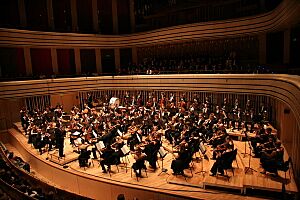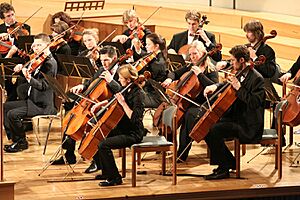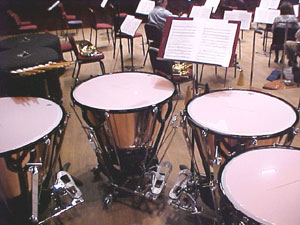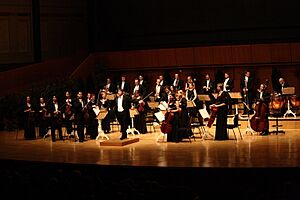Orchestra facts for kids
An orchestra is a large group of musicians who play instruments together. They usually perform classical music. A very big orchestra is often called a "symphony orchestra," and it can have around 100 players. A smaller group is known as a "chamber orchestra," which might have 30 to 40 musicians. The number of players depends on the music they are playing and the size of the hall. The word "orchestra" first meant the curved area in front of a stage in ancient Greek theaters where performers played. Over time, the word came to mean the musicians themselves.
Contents
Who Leads an Orchestra?
The orchestra is guided by a conductor. This person helps all the players perform together. They make sure the sound is balanced so every instrument can be heard clearly. The conductor also helps the orchestra play with the right feeling and emotion. Some small chamber orchestras can play without a conductor. This was common until the 19th century, when orchestras became very large. Then, a conductor was needed to make decisions and stand in front so everyone could see them.

What Instruments Are in an Orchestra?
The instruments in an orchestra are grouped into four main families: the strings, woodwind, brass, and percussion. Each group of instruments is called a "section." Every section has a main player, known as the "principal." This principal helps make decisions, like how the musicians should sit. For example, the principal of the string section makes sure all the players move their bows in the same direction.
The violins are split into first and second violins. The first violins usually play the main tune. The second violins often play the accompaniment, which supports the tune. The principal of the first violins is the orchestra's leader. In a professional orchestra, this person is usually the highest-paid musician.
The String Family
The strings are the biggest section in the orchestra. There are five main types of string instruments: violin, viola, cello, double bass, and harp. They play most of the time and form the main sound of the music. If they are not playing the tune, they are usually accompanying it.
The first and second violins play different notes. The first violins often have the melody. The string players sit at the front of the stage in a fan shape, in front of the conductor. The first violins are usually on the conductor's left. Then come the second violins, followed by the violas, and then the cellos. The double basses sit behind the cellos. Some conductors like to arrange them differently, for example, with the second violins on their right.
The Woodwind Family
The woodwind instruments sit in one or two rows behind the strings. There are five main woodwind instruments: flute, oboe, clarinet, saxophone, and bassoon. Many of these instruments also have different versions.
The flute has a smaller version called the piccolo. It plays an octave higher and is the highest instrument in the orchestra. Sometimes, there is also an alto flute, which plays lower than the regular flute. Most woodwind instruments need a reed to make a sound, but the flute does not.
The bassoon has a larger version called the contrabassoon, or double bassoon. It sounds an octave lower and is one of the lowest instruments in the orchestra. The clarinet also has a larger version, the bass clarinet, which can play as low as a bassoon. Usually, only one bass clarinet is found in a modern orchestra.
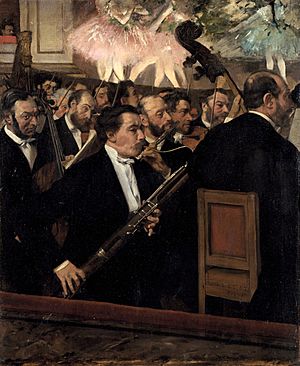
In a typical orchestra, there are usually two of each of the four main woodwind instruments. The special versions of these instruments are used when the music needs them. Newer pieces written after 1850 often use more instruments. Sometimes, a player might play more than one instrument, like a flute player also playing the piccolo in the same piece. If both instruments need to play at the same time, an extra player is needed.
The Brass Family
The brass section has four main types of instruments: trumpet, trombone, French horn, and tuba. Some of these instruments come in different sizes.
The trumpet can have slightly different sizes, including a bass trumpet, which plays lower notes. Trombones can be alto, tenor, bass, or contrabass trombones. The French horn has changed over the years. Modern horns usually have at least three valves. They often sit in a different spot from the other brass instruments. The tuba also comes in various sizes. There are very large ones called contrabass tubas. A smaller tuba, often called a euphonium or baritone horn, is also common.
The Percussion Family
The percussion section has the widest variety of instruments. The timpani, also known as "kettle drums," can be tuned to specific notes. They are the most common percussion instrument. Composers like Haydn and Mozart almost always used them, even with their smaller orchestras.
Other percussion instruments can include tuned instruments like the xylophone. Non-tuned percussion includes different kinds of drums, such as the bass drum and snare drum, and many others. The principal percussion player decides which musician will play which instrument. Percussionists need to work well as a team to make sure all parts are played correctly.
How Orchestras Began
It's hard to say exactly when the orchestra was invented because instruments have been played together for many centuries. If we define an orchestra as a group of string instruments with several players playing the same part, along with wind or percussion instruments, then orchestras started in the 17th century.
In Paris in 1626, King Louis XIII had an orchestra of 24 violins, called "24 Violons du Roi." Later, the English king Charles II wanted an orchestra like the French king's. So, he also had a string orchestra. Gradually, other instruments were added. At this time, someone usually played the harpsichord (the continuo part). This was often the composer, who would lead the orchestra from the keyboard during important parts of the music.
Clarinets joined the orchestra in the late 18th century, and trombones were added in the early 19th century. Orchestras were still quite small then. The saxophone was invented in the mid-19th century. While it was used in orchestras for a while, it soon became more common in wind bands and later in jazz bands.
The opera composer Richard Wagner made orchestras much larger because he kept asking for extra instruments. For his opera Lohengrin, he asked for a bass clarinet. For his series of four operas called The Ring of the Nibelung, he asked for a very specific number of players: 16 first violins, 16 second violins, 12 violas, 12 cellos, 8 double basses, 3 flutes and a piccolo, 3 oboes and a cor anglais, 3 clarinets and a bass clarinet, 3 bassoons, 3 trumpets and a bass trumpet, 3 tenor trombones and a double bass trombone, 8 horns (with 4 of them playing a special tuba), a bass tuba, percussion, and 6 harps.
Not all music written after Wagner needed such a huge orchestra. However, concert halls had become bigger, and composers were used to a wider range of sounds. Later composers sometimes added unusual instruments like a wind machine, sandpaper block, bottles, a typewriter, anvils, iron chains, a cuckoo whistle, or a Swannee whistle. These are not typical orchestral instruments. Sometimes a piano is used in the percussion section, for example, Igor Stravinsky used one in his piece Petrouchka. Sometimes, even voices are used in an orchestra.
Orchestras Today
Today, orchestras often perform in concert halls. They also play in opera houses for opera and ballet performances. Sometimes, they play in large stadiums for big outdoor concerts. Orchestras also record music in studios for CDs or for movies. Many famous orchestras can be heard easily and affordably every summer at the BBC Proms in London.
Some of the most famous orchestras today include: the New York Philharmonic Orchestra, the Boston Symphony Orchestra, the Chicago Symphony Orchestra, the Cleveland Orchestra, the Los Angeles Philharmonic Orchestra, the London Symphony Orchestra, the London Philharmonic Orchestra, the BBC Symphony Orchestra, the Royal Concertgebouw Orchestra, the Vienna Philharmonic Orchestra, the Berlin Philharmonic Orchestra, the Leipzig Gewandhaus Orchestra, the Singapore Symphony Orchestra, the St Petersburg Philharmonic Orchestra, the Israel Philharmonic Orchestra, and the NHK Symphony Orchestra (Tokyo). Many opera houses have their own orchestras, such as those at the Metropolitan Opera House, La Scala, or the Royal Opera House.
In many countries, young people who play instruments well can join youth orchestras in their local areas. In Britain, some of the best young musicians are chosen to play in the National Youth Orchestra of Great Britain. Other famous youth orchestras around the world include the Orquesta Sinfónica Simón Bolívar, the Gustav Mahler Youth Orchestra, the European Union Youth Orchestra, and the West-Eastern Divan Orchestra.
Images for kids
See also
 In Spanish: Orquesta para niños
In Spanish: Orquesta para niños


